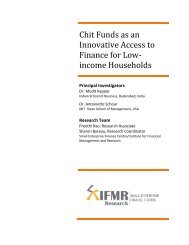Government of India Volume I: Analysis and Recommendations
Government of India Volume I: Analysis and Recommendations
Government of India Volume I: Analysis and Recommendations
Create successful ePaper yourself
Turn your PDF publications into a flip-book with our unique Google optimized e-Paper software.
MICRO-PRUDENTIAL REGULATION<br />
let that happen. For example, if consumers’ funds are kept in a bankruptcy remote vehicle,<br />
it should be possible to let the regulated person fail, without significantly affecting<br />
the interests <strong>of</strong> consumers. In the stock market, the success <strong>of</strong> clearing arrangements has<br />
made possible a regulatory stance where many securities firms have failed with no adverse<br />
consequences to consumers. The construction <strong>of</strong> the resolution corporation thus<br />
greatly changes how regulators would view failure.<br />
For systemically important financial institutions, safety <strong>and</strong> soundness should be<br />
taken to mean reducing the probability <strong>of</strong> firm failure, <strong>and</strong> for all other micro-prudentially<br />
regulated persons, it should mean reducing the probability <strong>of</strong> the event <strong>of</strong> regulated person<br />
failing to meet the obligations made to consumers. The Commission recognises that<br />
the acceptable probability <strong>of</strong> failure for regulated persons is not zero. However, if regulators<br />
are conferred with the objective <strong>of</strong> trying to minimise the probability <strong>of</strong> failure <strong>of</strong><br />
regulated persons, they may adopt an excessively restrictive approach that could result<br />
in an adverse effect on competition or innovation in financial markets. This is not good,<br />
particularly given the resolution mechanism being enshrined in the draft Code. Therefore,<br />
the Commission recommends that the regulators should work with the objective <strong>of</strong><br />
reducing the probability <strong>of</strong> failure <strong>of</strong> regulated persons <strong>and</strong> maintaining it at below an acceptable<br />
level. This acceptable level should be determined based on due consideration<br />
<strong>of</strong> the principles enunciated in the draft Code.<br />
Micro-prudential regulation must be distinguished from ‘systemic risk regulation’,<br />
also called macro-prudential regulation (see Chapter 9). Sound micro-prudential regulation<br />
is, <strong>of</strong> course, an essential ingredient <strong>of</strong> reducing systemic risk. Yet micro-prudential<br />
regulation focuses on one firm at a time, while systemic risk regulation involves the financial<br />
system as a whole. Micro-prudential regulation sees the proverbial trees to the forest<br />
surveyed by systemic risk regulation.<br />
6.2. A non-sector-specific micro-prudential framework<br />
Micro-prudential regulation has <strong>of</strong>ten been a sector-wise concern. Some countries have<br />
sector-specific laws, focusing on issues <strong>and</strong> instruments in the respective sectors. For example,<br />
micro-prudential regulation in <strong>India</strong> is conducted by various financial regulators,<br />
operating in different sectors, through an array <strong>of</strong> relevant laws. In this context, the Commission<br />
recommends non-sector-specific micro-prudential provisions in the draft Code,<br />
for the following reasons:<br />
1. There is underlying similarity in financial contracts- they are all built from a small number <strong>of</strong> contingent<br />
claims or obligations. There are common principles that underpin the micro-prudential<br />
regulation framework in different sectors, though specific risk-types to be addressed <strong>and</strong> the way<br />
instruments are to be used may differ. For example, there is significant convergence between<br />
the Basel II framework for banks <strong>and</strong> the European Union’s Solvency II framework for insurance<br />
companies. Unification <strong>of</strong> the law will yield more consistent treatment across apparently diverse<br />
activities, which are actually constructed from a small set <strong>of</strong> core ideas.<br />
2. As the financial system develops further, it will become increasingly difficult to draw sectorspecific<br />
lines on financial products <strong>and</strong> services being <strong>of</strong>fered. A common set <strong>of</strong> principles guiding<br />
the regulation <strong>of</strong> the entire financial system will help minimise the potential for regulatory<br />
gaps.<br />
3. Once problems <strong>of</strong> competition policy are addressed, <strong>and</strong> competition in the financial system<br />
heats up, easy sources <strong>of</strong> pr<strong>of</strong>it will be competed away. This will give firms a strong incentive<br />
to pursue regulatory arbitrage. The use <strong>of</strong> a single set <strong>of</strong> principles, consistently applied across<br />
different kinds <strong>of</strong> activities, will reduce the extent to which regulatory arbitrage might arise.<br />
4. Sector-specific regulators administering different sets <strong>of</strong> provisions create the possibility <strong>of</strong> a race<br />
to the bottom, where a sector regulator favours lax regulation in the interest <strong>of</strong> increasing the<br />
growth <strong>of</strong> the sector. The presence <strong>of</strong> non-sector-specific provisions will help curtail such destructive<br />
regulatory competition.<br />
FINANCIAL SECTOR LEGISLATIVE REFORMS COMMISSION 57



